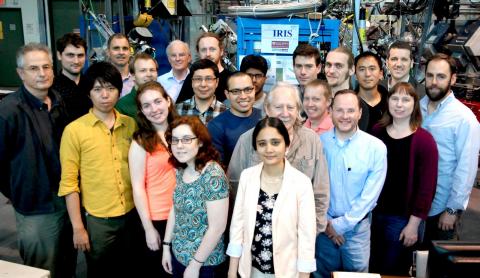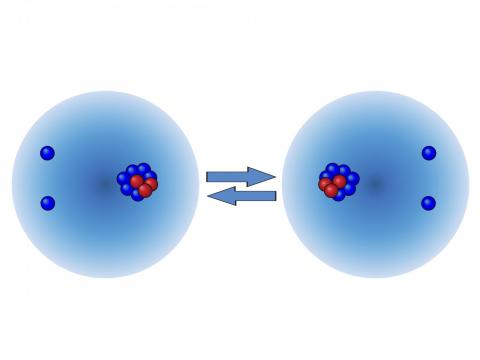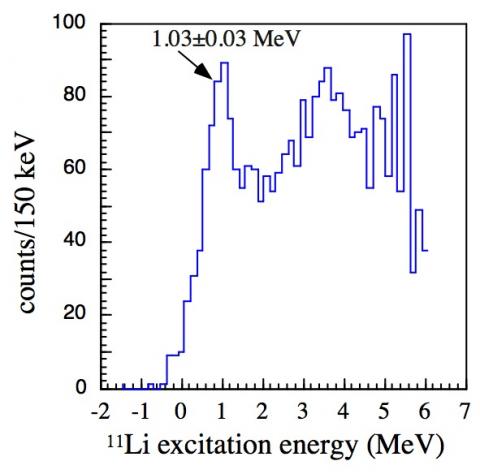


Atomic nuclei have been studied for about 110 years, but as of today, no single theory has emerged accounting for the multitude of different nuclei, called isotopes. Different theories are able explain common everyday isotopes equally well but diverge when used to predict the behaviour of more exotic – or rare – isotopes. TRIUMF’s ISAC facility provides researchers access to rare isotope beams to conduct experiments that seek to differentiate these theories in the ulitmate hope of identifying the one unified theory to describe all isotopes.
In the realm of rare isotopes, halo nuclei are particularily unique. Halo nuclei refer to an isotope where one or more neutrons orbit relatively far from a compact proton+neutron core in the nucleus. The halo neutrons relatively weakly bound to the rest of the nucleus and therefore the nuclei are very unstable. The first such nucleus discovered was Lithium-11 (Li-11), where two neutrons orbit are weakly coupled around a tightly-bound Lithium-9 core in such as way that removing any one neutron makes the whole nucleus fall apart, a so-called “Borromean” nucleus. The two neutrons make Li-11 large, as big as Gold-197, and it has been long speculated that the two neutrons could thus oscillate against the core in a “soft dipole resonance” state (see illustration). Over the past two decades, researchers have made various efforts to find evidence for the resonance; however, the challenge is that Li-11 beam intensities were historically a trillion times less than stable isotope beams. It is this state that the IRIS experiment was seeking in a recent experiment at TRIUMF, exploiting the world-leading intensity of ISAC’s Li-11 beams.
The novelty of the IRIS apparatus is the use of thin, solid deuterium or hydrogen targets that increase the luminosity (reaction probability) of interactions involving neutron-rich rare isotopes. In this experiment, a solid deuteron target was used to excite energy states within nuclei in the impinging Li-11 beam. By detecting the reaction products and measuring their energy and ejection angles, the team was able to reconstruct the excitation spectrum of Li-11. A prominent excitation peak at around 1 MeV was seen in the energy spectrum at low beam energy (see figure). The angular dependence of the state confirmed its nature as a soft dipole resonance aligned with theoretical calculations. This is the first result from IRIS.
The collaboration performed various model calculations attempting to predict this dipole resonance. The comparisons showed a first signature of the importance of tensor monopole interaction in Li-11. On the theoretical front, further developments are in progress. These impressive first results from IRIS have been recently published in Physical Review Letters DOI: http://dx.doi.org/10.1103/PhysRevLett.114.192502
Future experiments will use solid hydrogen targets to explore the resonance levels of other neutron-rich isotopes. Resonances play a key role in influencing the neutron-capture rates in the synthesis of heavy elements in neutron-rich environments (like supernovae and neutron stars). TRIUMF’s ARIEL and CANREB facilities will provide world-elading access to the rare neutron-rich isotopes and enable further research into this area.
IRIS is a project led by Saint Mary's University in collaboration with TRIUMF, RCNP (Japan), KEK, University of Guelph, Simon Fraser University and McMaster University. Isao Tanihata from RCNP, Osaka, and Shigeru Ishimoto from KEK have been key collaborators especially for the development of the solid deuterium target. The collaboration includes researchers in nuclear structure and reaction theory from Oak Ridge National Laboratory (G. Hagen, G. Jansen), Lawrence Livermore National Laboratory (I.J. Thomspon) in USA, Nihon University (T. Suzuki), University of Tokyo (T. Otsuka), and Osaka Institute of Technology (T. Myo) in Japan. Saint Mary’s University-TRIUMF postdoctoral fellow, Alisher Sanetullaev played a significant role in the commissioning of IRIS. The world-class research infrastructure has attracted graduate student Junki Tanaka, from Osaka University for experiments at IRIS.
As with all science endeavours, this result brought expertise from many groups on site. The IRIS team would like to thank everyone involved in this effort, including the Data Acquisition Group, the Detector Laboratory, Vaccuum Group, Controls Group, and Beamlines Group. The research team gratefully acknowledges the support from Canada Foundation for Innovation, grant-in-aid program of Japanese government, Nova Scotia Research and Innovation Trust, NSERC, Saint Mary's University and TRIUMF.
